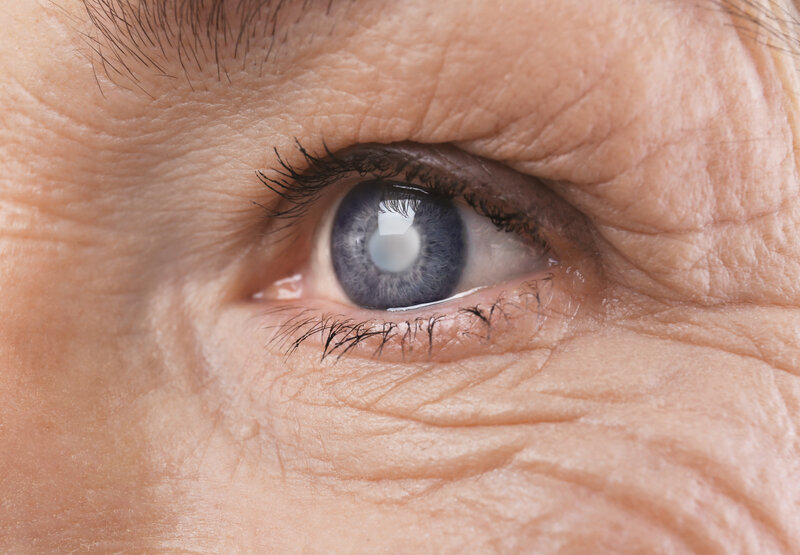All About Cataracts: Symptoms, Causes, & Treatment

The eye's lens is a transparent, curved structure behind the pupil. When the lens becomes cloudy, we call it a cataract. The development of a cataract is progressive, so what starts out as slightly blurry, cloudy, or diminished vision can lead to complete blindness over time without treatment.
Cataracts are quite common in the senior population, and nearly 50% of all adults 80 and over have some degree of cataract development. However, genetics, lifestyle, and environmental factors also play a role in whether a person develops cataracts, which is why we take a proactive approach to eye care. Fortunately, most cataracts can be treated, but early detection is essential.
Symptoms & Causes Of Cataracts
Have you ever noticed that someone’s pupils look a bit cloudy, almost like there is a pale blue or gray film over it? You may have seen this same type of cloudy film on the pupil of an older dog. That opacity is also due to cataract growth and a sign that your beloved companion can’t see like they used to - or may be completely blind.
Symptoms Of Cataract Growth:
Cataracts are easily caught during an annual eye exam unless they are very fast-growing. Some of the most common causes of cataracts are:
- Cloudy or blurry vision.
- Faded colors or a loss of vibrancy in the world around you. People with cataracts say things appear faded, yellowed, or more like sepia-toned images.
- Deteriorating vision during dusk and dark hours.
- Light sensitivity (lamps, overhead lights, and headlights may seem far brighter than they used to.
- Seeing halos around lights (which may also signify other vision issues, such as astigmatism).
- Double vision (which usually disappears as cataracts worsen).
- Changes in lens prescriptions over a faster period.
The Most Common Causes Of Cataracts
Age-related cataracts
The vast majority of cataracts grow due to age-related changes in our eyes and bodies. Most people 50+ have some degree of lens cloudiness, even if it never continues developing into cataracts.
Sometimes, people only develop cataracts in one eye. Others may have cataracts in both eyes at the same time. Or, one eye may develop a cataract faster than the other. Regardless, cataracts are not contagious and don’t “spread” from eye to eye.
Glaucoma
Like cataracts, glaucoma is another leading cause of vision loss, especially in the 60+ population. While glaucoma does not cause cataracts, the treatments used to slow down its progression may put you at higher risk for developing cataracts.
Eye injuries
Eye injuries make the eyes more prone to developing cataracts. This is why it’s so important to wear proper eye protection when playing sports, working outside, in work environments that put the eyes at risk, and so on. If you experience anything more than minor eye trauma, schedule an appointment with your optometrist to ensure you’ve received proper treatment and that your eyes are healing as they should.
NOTE: If you or your child plays sports, or you have a job requiring safety glasses, talk to us about ordering prescriptive protective lenses so you don’t have to sacrifice vision for safety - and vice versa.
Sun damage
Sun damage is one of the most common types of eye injury, accumulating over a lifetime. People who spend lots of time out in the sun, without proper sun protection (hats, UV-blocking sunglasses or safety glasses, etc.) have a higher risk factor for developing cataracts, and for their cataracts to be more severe.
Diabetes
Several medical conditions increase the risk of developing cataracts, but diabetes is at the top of that list. People who have type 2 diabetes almost always experience cataract-related vision loss, along with diabetic retinopathy. If you have diabetes - or pre-diabetes - it’s essential that you manage the disease to the best of your ability. We typically like to see patients with diabetes at least twice per year to maintain a proactive approach to their vision health.
Additional Risk Factors For Developing Cataracts
There are other risk factors associated with developing cataracts, which include:
- A family history of cataracts and vision loss. Genetics is a powerful force when it comes to physical well-being and vision. If your close family members have cataracts, speak to your optometrist. We may determine that bi-annual exams are best for you.
- Smoking. People who smoke are twice as likely to develop cataracts (and they’re twice as likely to develop age-related macular degeneration or AMD).
- Drinking too much alcohol. Similarly, people who drink three or more alcoholic beverages per day have higher rates of cataract growth.
- Steroid use. While using steroids to bulk up increases your risk of cataracts, so does the long-term use of steroids to treat medical conditions, allergies/respiratory issues, and so on. This is why it’s so important to let your optometrist know what medications you’re on so we know to keep a closer eye on you if a medication is known to increase the risk of vision loss.
Treating Cataracts Begins With Healthy Lifestyle Choices
A quick review of the risk factors and common causes of cataracts is evidence of how lifestyle choices matter.
Making smart, disciplined choices about diet, exercise, and sleep habits—and minimizing excessive use of tobacco or alcohol products - prevents the onset of health conditions most likely to cause cataracts. If you develop cataracts, healthy lifestyle choices slow down cataract growth and support the success of cataract treatments.
We use the least invasive treatments first, so the most common treatments for cataracts are:
Focus on slowing down the development of cataracts
The first thing you can do is take a proactive approach to prevent cataracts from worsening or slowing down their progression. This includes things like:
- Quitting smoking, reducing alcohol consumption, and making any lifestyle changes you know will improve overall health.
- Managing existing health conditions.
- Diligently protecting your eyes from further sun damage.
- Keeping up with eyeglasses and contact lens prescriptions to optimize existing vision.
- Increase the use of warm lights for task lighting or when reading to minimize eye strain and support remaining vision.
Speak to your optometrist about cataract surgery
Cataract surgery has come so far in the past thirty years. While we hesitate to call any surgery “routine,” cataract surgery has a very high success rate with minimal risk involved. During the surgery, the ophthalmologist removes your cloudy natural lens and replaces it with a synthetic intraocular lens (IOL).
Over time, people with IOLs may notice their vision is cloudy again. This usually occurs because the part of the eye that holds the lens (the lens capsule) becomes cloudy. If this happens, your surgeon can schedule you for laser surgery to open and clear the capsule, restoring vision again.
Eye-To-Eye Family Vision Care Takes A Proactive Approach To Cataract Prevention & Treatment
Has your vision become cloudier than normal, making you suspect a cataract? Schedule an appointment with Eye to Eye Family Vision Care. We take a proactive approach to cataract prevention and treatment.

